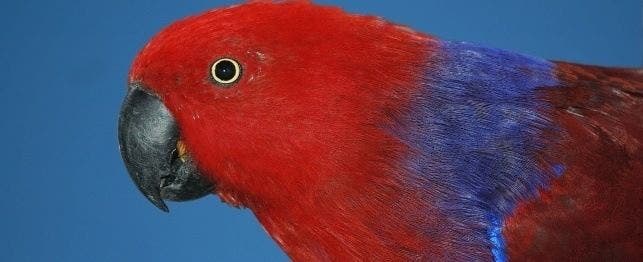
Choosing a Red-sided Eclectus
The red-sided eclectus (Eclectus roratus polychloros) is one of nine recognized subspecies of eclectus parrots. Although they have previously been considered better aviary birds than pets, this opinion is rapidly changing. Many people have enjoyed these beautiful birds as wonderful and enchanting pets. They don’t talk as well as other parrots but are very clean and relatively odorless.
Males tend to be the gentler sex, but this is controversial. For this reason, many people feel that males are more appropriate for families with smaller children.
Red-sided eclectus are found in Australia, New Guinea and the South Pacific Islands. Females have distinctive differences in the plumage between the subspecies, however the males are difficult to differentiate. The difficulty of identification of males often leads to inadvertent hybridization.
Red-sided eclectus are found on the West Papuan islands of Indonesia and in New Guinea. Life span is probably up to 40-plus years.
Appearance and Personality
Eclectus are unique among parrots in their strikingly dimorphic plumage color. The females are a deep scarlet to bright red with black beaks. The males are brilliant green with yellow-orange upper beaks. Early ornithologists even considered them different species due to the striking dimorphism. Their feathers have a soft, almost fur like appearance. They are large stocky parrots with short square tails.
The male is a brilliant forest green. He has brilliant red patches on the sides and under wing coverts, blue bend to the wing and dark blue flight feathers. The female has a distinct blue feather ring around the eye like blue eyeliner. Her red is brilliant and her breast is a brilliant blue purple, which is separated from the red above by a distinct sharp line of demarcation. The under tail coverts are bright red. The tail feathers are solid red. The outer edges of the primaries are green.
Eclectus will often appear stoic but are interested in activities around them. They should always be provided with toys, especially wooden blocks or other toys, which can be chewed, and branches from non-toxic trees. In order to ensure safety, companion eclectus should not be allowed unsupervised freedom in the home as they often encounter toxins or dangerous items. Young eclectus should be socialized to many people and exposed to a variety of situations such as new cages, toys, visits to the veterinarian, handling by friends, wing and nail clips, etc. to avoid fear of novel situations.
Feeding
Eclectus do well when provided with plenty of fruits and vegetables. Their diet should be comprised of 75 to 80 percent fruits and vegetables and 20 to 25 percent pellets. Treats may be given in small amounts especially as rewards for good behavior. Fresh clean water must be provided every day. Vitamin supplements are not needed for birds that are eating a formulated and nutritionally rich diet.
Grooming
Routine bathing or showering is vital to maintaining good plumage and skin condition. The fine feathering of the eclectus is especially beautiful when they receive routine baths. Ideally birds should be taken outdoors on a warm day and lightly sprinkled and allowed to dry in the sun. Indoor birds can be misted or bathed in the shower and allowed to dry in a warm room or dried with a blow drier.
Care should be taken not to clip the wing feathers excessively. Clip only enough so the bird will glide to the floor.
Housing
Eclectus should be provided with as large a cage as possible. Appropriate toys should be provided.
Breeding
Breeding season and clutch size – Eclectus parrots are prolific breeders and many pairs will breed year round. The prominent breeding season is the spring. Females may be aggressive toward males. There are reports of eclectus breeding successfully until age 28.
Some eclectus breed in nest boxes and some breed on perches. Provide a Z-box, rectangular or vertical nest box approximately 18 inches by 18 inches by 24 inches. Females may stay in the box most of the time. Pine shavings make excellent nest material. Breeding cage should be as large as practical but at least 3 feet by 3 feet by 6 feet.
Eclectus are easy to hand rear and will do well on hand rearing formulas. The sexes can be distinguished at a very early age and the down tends to be black in female chicks and grey in males. At about 4 to 5 weeks, the head will take on a green or red cast as feathers emerge and tails feathers will begin to emerge verifying sex. Eclectus chicks must be handled very gently to avoid fearful or aggressive behavior.
Common Diseases and Disorders
The red-sided eclectus is a relatively healthy bird. The following diseases have been reported in this bird.
- Feather picking
- Psittacine Beak and Feather Disease
- Polyoma virus infection
- Psittacosis
- Bacterial infections
- Candida (yeast) infections
- Ingestion of toxins such as heavy metals
- Infertility and female aggression
- Vitamin A deficiency